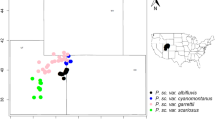Abstract
PCR-based multi-locus DNA fingerprints represent one of the most informative and cost-effective measures of genetic diversity and are useful population-level biomarkers of toxicologic and other anthropogenic impacts. However, concerns about reproducibility of DNA fingerprints have limited their wider use in environmental biology. We assessed polymorphism and reproducibility of two common fingerprinting techniques, RAPD (randomly amplified polymorphic DNA) and AFLP (amplified fragment length polymorphism), in pedigreed populations of rainbow trout (Oncorhynchus mykiss) to derive general rules for selective removal of problematic fingerprint bands. We found that by excluding bands that comprised less than 1% of total intensity, and by excluding the largest and smallest 10% of the bands, we could achieve nearly 100% reproducibility of AFLP fingerprints. Similar application of band exclusion criteria to RAPD fingerprints did not significantly enhance their reproducibility, and at least 15% of RAPD bands were not fully repeatable, heritable, or transmittable. The RAPD technique produced more polymorphic fingerprints than AFLP; however, considering that a substantial proportion of RAPD markers did not demonstrate Mendelian inheritance patterns, the AFLP methodology is to be preferred for future research.
Similar content being viewed by others
References
Armour, J.A.L., Neumann, R., Gobert, S. and Jeffreys, A.J. (1994). Isolation of human simple repeat loci by hybridization selection. Human Mol. Gene. 3, 599–605.
Asahida, T., Kobayashi, T., Saitoh, K. and Nakayama, I. (1996). Tissue preservation and total DNA extraction from fish stored at ambient temperature using buffers containing high concentration of urea. Fish. Sci. 62, 727–30.
Bickham, J.W. and Smolen, M.J. (1994). Somatic and heritable effects of environmental genotoxins and the emergence of evolutionary toxicology. Environ. Health Perspect. 102(Suppl. 12), 25–8.
Ellsworth, D.L., Rittenhouse, K.D. and Honeycutt, R.L. (1993). Artifactual variation in randomly amplified polymorphic DNA banding patterns. Biotechniques 2, 214–7.
Evenden, A.J. and Depledge, M.H. (1997). Genetic susceptibility in ecosystems: the challenge for ecotoxicology. Environ. Health Perspect. 105, 849–54.
Hadrys, H., Balick, M. and Schierwater, B. (1992). Applications of random amplified polymorphic DNA (RAPD) in molecular ecology.Mol. Ecol. 1, 55–63.
Janssen, P., Coopman, R., Huys, G. Swings, J., Bleeker, M., Vos, P., Zabeau, M. and Kersters, K. (1996). Evaluation of the DNA fingerprinting method AFLP as a new tool in bacterial taxonomy. Microbiology 142, 1881–93.
Krane, D.E., Sternberg, D.C. and Burton, G.A. (1999). Randomly amplified polymorphic DNA Profile-based measures of genetic diversity in crayfish correlated with environmental impacts. Environ. Toxicol. Chem. 18, 504–8.
Mariette, S., Lecorre, V. and Kremer, A. (1999). Sampling within the genome for measuring within-population diversity: trade-offs between markers. In E.M. Gillet (ed) Molecular Tools for Biodiversity. Compendium of the Research Project: Development, Optimization and Validation of Molecular Tools for Assessment of Biodiversity in Forest Trees. European Union DGXII Biotechnology FW IV Research Programme.
Meunier, J.-R. and Grimont, P.A.D. (1993). Factors affecting reproducibility of random amplified polymorphicDNAfingerprinting. Res. Microbiol. 144, 373–9.
Mueller, U.G., Lipari, S.E. and Milgroom, M.G. (1996). Amplified fragment length polymorphism (AFLP) fingerprinting of symbiotic fungi cultured by the fungus-growing ant Cyphomyrmex minutus. Mol. Ecol. 5, 119–22.
Nadig, S.G., Lee, K.L. and Adams, S.M. (1998). Evaluating alterations of genetic diversity in sunfish populations exposed to contaminants using RAPD assay. Aquat. Toxicol. 43, 163–78.
Paran, I., Aftergoot, E. and Shifriss, C. (1998). Variation in Capsicum annuum revealed by RAPD and AFLP markers. Euphytica 99, 167–73.
Park, Y.-H. and Kohel, R.J. (1994). Effect of concentration of MgCl2 on random-amplified DNA polymorphism. Biotechniques 4, 652–5.
Perez, T., Albornoz, J. and Dominguez, A. (1998). An evaluation of RAPD fragment reproducibility and nature. Mol. Ecol. 7, 1347–57.
Rodzen, J.A., Agresti, J.A., Tranah, G. and May, B. (1998). Agarose overlays allow simplified staining of polyacrylamide gels. Biotechniques 25, 584.
Schweder, M.E., Shatters Jr., R.G., West, S.H. and Smith, R.L. (1995). Effect of transition interval between melting and annealing temperatures on RAPD analyses. Biotechniques 19, 38–42.
Sharma, S.K., Knox, M.R. and Ellis, T.H.N. (1996). AFLP analysis of the diversity and phylogeny of Lens and its comparison with RAPD analysis. Theor. Appl. Gene. 93, 751–8.
Taggart, J.B., Hynes, R.A., Prodoehl, P.A. and Ferguson, A. (1992). A simplified protocol for routine total DNA isolation from salmonid fishes. J. Fish Biol. 40, 619–33.
Theodorakis, C.W. and Shugart, L.R. (1997). Genetic ecotoxicology II: population genetic structure in mosquitofish exposed in situ to radionuclides. Ecotoxicology 6, 335–54.
Vos, P., Hogers, R., Bleeker, M.R., van de Lee, T., Hornes, M., Fritjers, A., Pot, J., Peleman, J., Kuiper, M. and Zabeau, M. (1995). AFLP: a new technique for DNA fingerprinting. Nucl. Acids Res. 23, 4407–14.
Welsh, J. and McClelland, M. (1990). Fingerprinting genomes using PCR with arbitrary primers. Nucl. Acids Res. 18, 303–6.
Williams, J.G.K., Kubelik, A.R., Livak, K.J., Rafalski, J.A. and Tingey, S.V. (1990). DNA polymorphisms amplified by arbitrary primers are useful as genetic markers. Nucl. Acids Res. 18, 6531–5.
Author information
Authors and Affiliations
Corresponding author
Rights and permissions
About this article
Cite this article
Bagley, M.J., Anderson, S.L. & May, B. Choice of Methodology for Assessing Genetic Impacts of Environmental Stressors: Polymorphism and Reproducibility of RAPD and AFLP Fingerprints. Ecotoxicology 10, 239–244 (2001). https://doi.org/10.1023/A:1016625612603
Issue Date:
DOI: https://doi.org/10.1023/A:1016625612603




